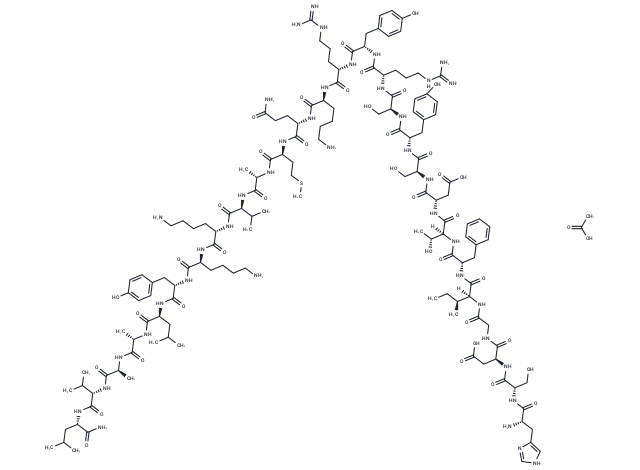Shopping Cart
- Remove All
 Your shopping cart is currently empty
Your shopping cart is currently empty

PACAP (1-27), human, ovine, rat acetate (PACAP 1-27 acetate) is a novel neuropeptides originally isolated from bovine hypothalamus, also found in humans and rats.

| Pack Size | Price | Availability | Quantity |
|---|---|---|---|
| 1 mg | $153 | In Stock | |
| 5 mg | $450 | In Stock | |
| 10 mg | $663 | In Stock | |
| 25 mg | $987 | In Stock | |
| 50 mg | $1,390 | In Stock | |
| 100 mg | $1,880 | In Stock |
| Description | PACAP (1-27), human, ovine, rat acetate (PACAP 1-27 acetate) is a novel neuropeptides originally isolated from bovine hypothalamus, also found in humans and rats. |
| In vitro | Radioligand receptor binding assays with I-monoiodinated PACAP (1-27), human, ovine, rat confirms the presence of PAC -receptors on AR4-2J cells, since PACAP (1-27), human, ovine, rat and PACAP(1–38) equipotently displaces radioligand binding with a Kd of 1-2 nM, whereas vasoactive intestinal peptide (VIP) is 1000-fold less potent. PACAP (1-27), human, ovine, rat exhibits a distinct and much higher susceptibility to VIP-amino acid substitutions. PACAP (1-27), human, ovine, rat has potency and binding affinity to stimulate IP3 and cAMP formation in AR4-2J cells[2]. |
| In vivo | The inhibitory effect of pituitary adenylate cyclase activating polypeptide (PACAP (1-27), human, ovine, rat) on the increase in total pulmonary resistance (RL) causes either by allergen or histamine in anaesthetized, ventilated guinea-pigs is studied. PACAP (1-27), human, ovine, rat given via i.v. infusion (0.045-4.5 nmol/kg/min) dose-dependently reduces the increase in RL caused by inhaled ovalbumin and histamine. At the highest dose, PACAP (1-27), human, ovine, rat prevented the increase in RL caused by ovalbumin and histamine completely. Infusion of PACAP (1-27), human, ovine, rat and the β2-adrenoceptor agonist, salbutamol (0.045-4.5 nmol/kg/min) inhibit the increase in RL similarly, but salbutamol increases the heart rate more than PACAP (1-27), human, ovine, rat[3]. |
| Alias | PACAP 1-27 acetate, PACAP (1-27), human, ovine, rat acetate(127317-03-7 free base) |
| Molecular Weight | 3207.71 |
| Formula | C144H228N40O41S |
| Storage | keep away from moisture | Powder: -20°C for 3 years | In solvent: -80°C for 1 year | Shipping with blue ice. | |||||||||||||||
| Solubility Information | DMSO: 5 mM | |||||||||||||||
Solution Preparation Table | ||||||||||||||||
DMSO
| ||||||||||||||||

Copyright © 2015-2024 TargetMol Chemicals Inc. All Rights Reserved.